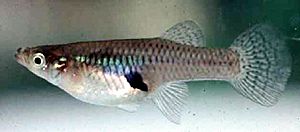Mosquitofish facts for kids
Quick facts for kids Mosquitofish |
|
|---|---|
 |
|
| Female | |
 |
|
| Male | |
| Conservation status | |
| Scientific classification |
The mosquitofish (Gambusia affinis), also called the western mosquitofish, is a small fish. It belongs to a group of fish known as Poeciliidae. This fish originally comes from the southern and midwestern United States. It also lives along the east coast of Mexico.
People have moved mosquitofish to many other places around the world. These places include Hawaii, Puerto Rico, and Australia. In some of these new homes, the mosquitofish has become an invasive species. This means it causes problems for the local environment. Some scientists believe the western mosquitofish has had the biggest impact on the environment of any fish in its family.
Contents
About the Mosquitofish
What Does It Look Like?
Adult male western mosquitofish are quite small. They usually grow to about 4 centimeters long. Female mosquitofish are a bit larger, reaching up to 7 centimeters. This fish has a round tail fin.
Where Does It Live?
The mosquitofish is very tough. It can live in water that is twice as salty as the ocean. It can also survive in very warm water, up to 43°C (109°F). This helps it live in many different places.
What Does It Eat?
Mosquitofish are not picky eaters. They eat algae, which are tiny plant-like organisms. They also eat insects and other small invertebrates. These are animals without backbones. A mosquitofish can eat more than its own body weight every single day!
Why Mosquitofish Were Moved
In the early 1900s, people started moving western mosquitofish to new areas. They hoped the fish would eat mosquitoes and their babies (larvae). The idea was to control mosquito populations. However, this plan often did not work out as expected.
Sometimes, there were even more mosquitoes than before. This happened because the mosquitofish ate or outcompeted other fish. These other fish were often better at controlling mosquitoes. The mosquitofish also ate insects that naturally preyed on mosquitoes. Plus, they ate tiny water animals called zooplankton. This left more food for mosquito larvae to grow.
How It Harms Other Animals
The western mosquitofish can be very aggressive. It might attack larger fish by nipping their fins. It also eats the eggs and babies of other fish. Smaller fish are often eaten whole by mosquitofish. They especially like to eat frog eggs and tadpoles.
When mosquitofish are put into a new pond or lake, there can be an algal bloom. This is when too much algae grows. It happens because the mosquitofish eats or kills the animals that usually keep the algae in check. The western mosquitofish is a reason why many other species are now in danger. For example, it threatens the Railroad Valley springfish in Nevada. It also harms the Sonoran topminnow in Arizona and a type of damselfly in Hawaii.
Reproduction and Life Cycle
Female western mosquitofish usually have about 60 babies at a time. But they can have as many as 300! The eggs stay inside the mother's body until they hatch. This means the babies are born alive, not laid as eggs in the water.
Western vs. Eastern Mosquitofish
There are two main types of mosquitofish: the western mosquitofish (G. affinis) and the eastern mosquitofish (G. holbrooki). For a long time, people thought they were the same species. They were both called G. affinis. However, scientists now know they are different. In places like Australia, many records that say "G. affinis" actually refer to the eastern mosquitofish.
Images for kids
See also
 In Spanish: Pez mosquito para niños
In Spanish: Pez mosquito para niños




